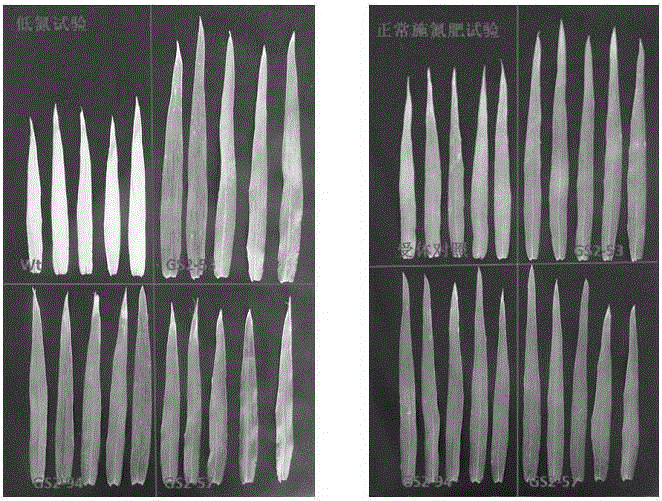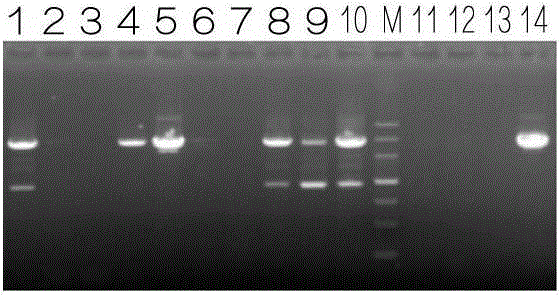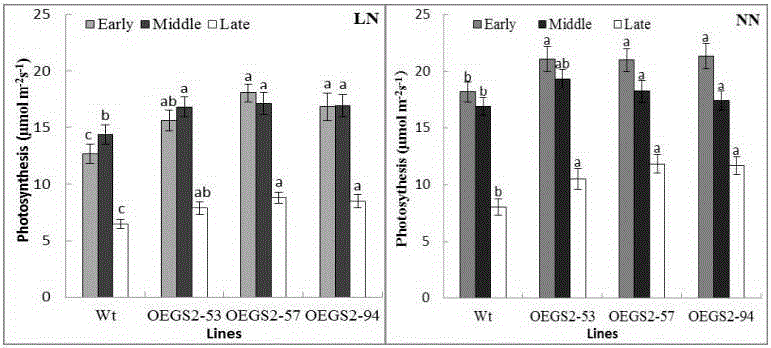Method for culturing root-growth-enhanced leaf-ageing-delayed transgenic plant
A technique for transgenic plants and plant roots, applied in the field of cultivation of transgenic plants
- Summary
- Abstract
- Description
- Claims
- Application Information
AI Technical Summary
Problems solved by technology
Method used
Image
Examples
Embodiment 1
[0028] Embodiment 1, the discovery of TaGS2 protein and its coding gene
[0029] Firstly, the full-length was spliced according to the EST sequence of wheat GS2UnigeneTa.24748, and GS2 gene primers were designed according to its conserved sequence, and Xiaoyan 54 genomic DNA was used as a template to screen out primers suitable for genome amplification, and the amplified products were initially sequenced. Then design primers according to the obtained sequence for screening the Xiaoyan 54BAC library. The screened BAC monoclonal plasmid was sequenced, and finally a TaGS2 gene was obtained, distributed on the A genome of wheat, named TaGS2-A1.
[0030] Primers were designed according to the genome sequence of the TaGS2-A1 gene, and the target fragment was amplified using the cDNA of wheat (wheat cultivar Xiaoyan 54) as a template. After sequencing, a cDNA sequence (SEQ ID NO: 1) of about 1.3 kb was obtained, which contained a complete ORF; it encoded a polypeptide consisting...
Embodiment 2
[0031] Embodiment 2, the cloning of TaGS2-A1 gene and the isolation of its promoter
[0032] 2.1 Gene cloning: Extract the total RNA of wheat variety Xiaoyan 54 with Trizol reagent from Invetrogen Company, after DNaseI (RNase-free) treatment, take 4 μg and use M-MLV reverse transcriptase from Promega Company to carry out reverse transcription to synthesize cDNA. The chain is used as a template for PCR amplification to obtain PCR amplification products.
[0033] The sequences of PCR primers (forward primer and reverse primer respectively introducing BamHI and KpnI restriction sites) are as follows:
[0034] Forward primer: 5′-AGTGGATCCATGGCGCAGGCAGTGGTGCCGGCGATG-3′ (SEQ ID NO: 4);
[0035] Reverse primer: 5'-TCAGGTACCTCATACCTTCAGCGCCAGCTTCTTG-3' (SEQ ID NO: 5).
[0036] PCR reaction system: 39.5 μl of ultrapure water, 5 μl of 10×PCR buffer, 2 μl of template, 1 μl of forward and reverse primers with a concentration of 10 μM, 0.5 μl of KOD enzyme (5u / μl), and 1 μl of dNTPs (1...
Embodiment 3
[0046] Embodiment 3, the construction of recombinant expression vector
[0047] Construction of a recombinant expression vector for TaGS2-A1 overexpression in wheat: First connect the TaGS2 gene to the Ubiquitin promoter of the expression vector pUBI:cas, then replace the Ubiquitin promoter with the TaGS2-A1 promoter, and finally construct a Sub+gene recombinant expression vector pTaGS2::TaGS2.
[0048] The specific process is as follows:
[0049] 3.1. Digest pMD18-TaGS2 with restriction endonucleases BamHI and KpnI (incomplete digestion), and recover a fragment of about 1.3kb (including the complete ORF sequence of TaGS2-A1).
[0050] 3.2. Digest pUBI:cas with restriction endonucleases BamHI and KpnI to recover the vector backbone.
[0051] 3.3. Ligate the small fragment recovered in step 1 with the vector backbone recovered in step 2 to obtain recombinant plasmid A (pUBI-TaGS2).
[0052] 3.4. Digest pMD18-pTaGS2 with restriction enzymes PstI and BamHI, and recover a fra...
PUM
 Login to View More
Login to View More Abstract
Description
Claims
Application Information
 Login to View More
Login to View More - R&D
- Intellectual Property
- Life Sciences
- Materials
- Tech Scout
- Unparalleled Data Quality
- Higher Quality Content
- 60% Fewer Hallucinations
Browse by: Latest US Patents, China's latest patents, Technical Efficacy Thesaurus, Application Domain, Technology Topic, Popular Technical Reports.
© 2025 PatSnap. All rights reserved.Legal|Privacy policy|Modern Slavery Act Transparency Statement|Sitemap|About US| Contact US: help@patsnap.com



